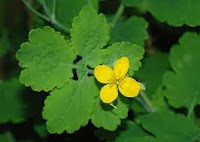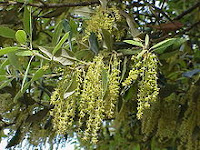The Greater celandine despite its name is not a relative of the lesser celandine (Ranunculus ficaria) which is a member of the buttercup family. The Greater celandine is a relative of the Papaveraceae or poppy family. The flowers form a cross and are a lighter shade of yellow than the Lesser celandine which also has more petals than the Greater one. The Greater celandine likes boggy places and is often found in woods. This plant can grow to more than a metre high and spreads too.
In the ancient world, the Greater celandine’s sap was used for eye problems, especially with milk, to remove specks and film from the cornea, but this is not recommended. Dioscorides boiled the juice with honey to remove “slimy things” from eyes. Pliny tells us that the plant flowers when swallows arrive in early summer and withers when they depart for warmer climes just before autumn sets in. This fact gives rise to another name for this plant, Swallow wort. Chelidon is Greek for swallow (the bird) and it is thought that the English word celandine is a corruption of this.
 The sap from the plant is orange, and if ingested in quantities will turn your urine yellow, just as when you eat asparagus you have green urine. In the 14th century it was used with other herbs as a blood purifier and to detox the system and the sap was put on fresh wounds to stop them getting infected. Preliminary clinical trials on extracts of the plant have shown that it may have antimicrobial properties.
The sap from the plant is orange, and if ingested in quantities will turn your urine yellow, just as when you eat asparagus you have green urine. In the 14th century it was used with other herbs as a blood purifier and to detox the system and the sap was put on fresh wounds to stop them getting infected. Preliminary clinical trials on extracts of the plant have shown that it may have antimicrobial properties. Ancient herbalists believed that because of the orange-yellow sap it would be good to cure jaundice, but there have been some reports, although not many, that the plant can cause severe, if no fatal liver damage.
The whole plant can irritate sensitive skin and is allergenic, so be careful if you touch it. The sap can stain your hand yellow, just as turmeric does. Large doses of it can cause sleepiness and for this reason it is sometimes used today as a mild sedative. The plant contains the alkaloid chelidonine which is similar to the papaverine found in poppies and which has an antispasmodic and sedative effect on the bile duct and bronchi. It may also have some cancer preventative properties according to some clinical studies, but this has yet to be proven.
The German Commission E has approved the use of the Greater celandine for dyspepsia, but other countries such as the US
The sap from the plant has been used in the past to get rid of ringworm and warts and the seeds contain a fatty oil which seems not to have been employed in remedies on its own.
 A tisane can be made from the whole dried plant, which is best gathered when in flower, between May and July, when the plant can also be used fresh. The tisane promotes sweating in fevers and is made from one ounce of the whole dried herb to 1 pint of boiling water. Pour the water over the plant and leave it to steep for 15 to 20 minutes, then strain and drink in small wineglass doses three times a day. You can make a decoction by boiling the whole herb in water until the water has reduced by half and use for stones and gravel in the internal organs.
A tisane can be made from the whole dried plant, which is best gathered when in flower, between May and July, when the plant can also be used fresh. The tisane promotes sweating in fevers and is made from one ounce of the whole dried herb to 1 pint of boiling water. Pour the water over the plant and leave it to steep for 15 to 20 minutes, then strain and drink in small wineglass doses three times a day. You can make a decoction by boiling the whole herb in water until the water has reduced by half and use for stones and gravel in the internal organs. However you should remember that this plant is not recommended for use.





































